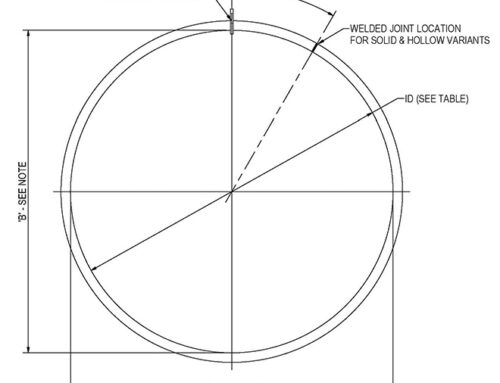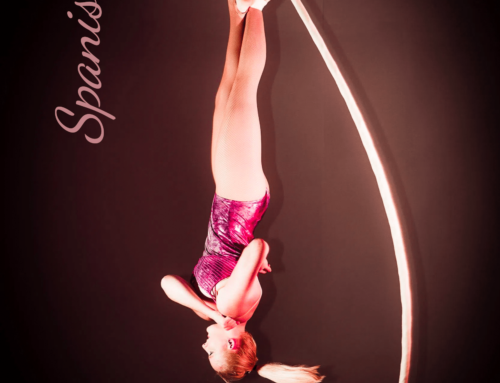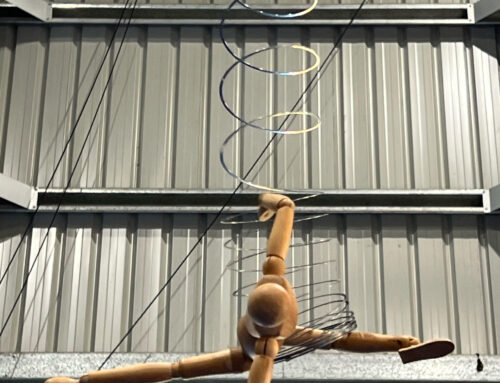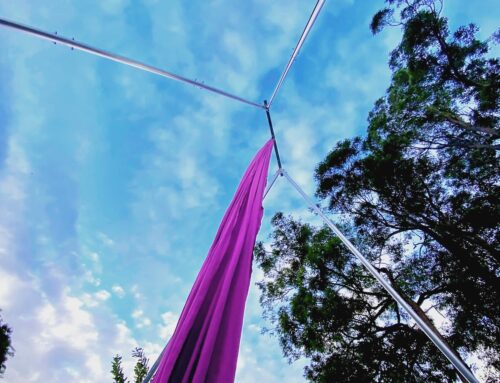If you had a choice, would you have an aerial rig at your home (provided you have enough space) or prefer to do your aerial training at your usual indoor circus training space? The obvious benefits of training at your home is that you are not limited to the time you may train and for how long. But training at home might also mean that you do not have a coach to guide you through your training sessions. That might have been the case until the Covid-19 pandemic changed the nature of coaching. Now more and more online coaching has become available to the circus community. I am an online coach and I can help students achieve high skill levels from sitting behind my computer and seeing the student train instead of physically being in the same studio. A great coach should not have to demonstrate a skill for you to achieve your goals. Competent coaches should know safe progressions and have a flexible skill set to help you on your path to success. Career coaches are not the ones on the gear during your lesson, they are the ones standing next to you with the knowledge and the encouragement. Even before Covid-19, I can safely say I haven’t demonstrated for a student in a over 30 years. It is not necessary. I therefore encourage the freedom of training at home, as long as your rigging and gear is safe, you use a safety mat of some sort, and you get regular coaching so that you are not training bad habits or missing important steps of progression.
If you are inquisitive about buying an aerial rig, this blog is meant for you. I will discuss a few important things to consider when buying an aerial rig. This will give you a better understanding of what is available and the important facts that need to influence your decision. Every week I see posts on Instagram and Facebook of circus enthusiasts training on a free-standing aerial rig in their garden. I worry when I see how much their rig moves and wobbles while they are doing basic static poses on their aerial hoops or trapezes. I understand that students want to keep training and that there is a lack of engineered, certified and useable rigs on the market to purchase. There is a lot out there, but what is safest? Which rig has the most useable height? Which is best for you? Should economics be the greatest influence over what type of rig you will buy? Looking at the different prices of rigs for sale, they are not cheap, but the best ones are certainly more expensive. Are you getting your money’s worth if your personal safety is at risk? As a qualified rigger, circus acrobatic and aerial coach and a rigging manufacturer, I reckon not. Irrespective of the rig you choose, here are my guidelines to help you make the right choice for your circumstance.
Space
Will the rig fit into your garden? The rig’s “footprint” is the greatest area that any part of the rig will need. This is usually the area within the supporting poles of your rig. The larger the area you have, the higher the rig you can buy. If you are lucky enough to have more space, you might choose to buy a guyed-out rig using 4 peg points that guy cables attach and tension onto. These rigs can be as tall as a flying trapeze rig and are designed for the student to be able to swing on them, unlike the free-standing rigs. Some free-standing rigs have a large footprint, but are not very high. This puts a lot of strain on each pole due to the large angle on them. This will make the poles bow or wobble when used. A too-large footprint is not safe for the sleeves which are used to join the sections of the poles.
Height
Once you have decided the space you can use for your rig, what height should you get? I have seen students on tri-pod style rigs using an aerial hoop. The hoop was spinning and each time the student leaned out they hit one of the supporting poles. With a tripod rig you need to be at least 3 ft lower than the top to miss the poles. But being lower sometimes means that you are too close to the ground! Your rig should give you enough height to be able to spin and use your apparatus freely, as if you were in your indoor training space, with a safety mat under you. If you are looking at buying a tripod rig, consider that the useable height is at least 3 ft less than that of the total height of the rig.
User-friendly
Aerial rig suppliers often use advertising slogans like “light weight” or “easy to set up alone” or “only two people needed to set up”. They make it seem that you might need to move it regularly, but it is uncommon that people need to move their rig once they set it up. Due to our current isolation and social distancing, I can’t see the need or reason to move your rigs often, and even when this pandemic is behind us, how often will you need to move your rig? Making the rig “light weight” also makes it weaker, so is it worth sacrificing strength for mobility, if you are not going to move it often? Another consideration to make is how easy is it to set up your gear on your rig and remove it after training? Does the rig have more than one rigging point? You might want two points if you want to use a trapeze bar. Can you change the height of your gear easily, once it is set up?
Strength
How strong should your rig be? When you buy your circus gear, you get “rated” slings or “certified” swivels and carabiners, but do you require this for your rig as well? Does your rig have a tag or certified plate to show the Safe Working Load (SWL/WLL)? By law, any human supporting aerial rig should be strong enough to hold 10 times the weight of the person/s plus their gear. So, if you weigh 150lbs (68kgs) and your gear weighs 10lbs (4.5kgs), your rig should be rated to be able to hold 1600 lbs (725kgs). I can hear you ask “why does it need to be this much?” It has evolved to this 10:1 safety ratio because too often in the past, people have been injured or hurt badly due to a piece of circus equipment breaking, causing them to fall down. Numerous tests have been done for many years to find out what dynamic load a circus performer applies to their gear and rigging. The results have been the guide to this decision. Doing tempo beats under your static trapeze bar will generate a surprising amount of dynamic weight to the system that you are hanging off. How will your rig react to these kinds of loads?
Liability
Will your home insurance include the aerial rig use in your cover? Your insurance agent might want proof that your rig has been built to withstand the kind of load that you will apply on it. This might require you to have the engineering specs for the rig that you have bought, as proof of its strength. Every manufacturer should have their own public liability insurance cover for the rig that they are selling, so make sure that you ask them for this in case you need it to show your insurance agent. Will your home insurance cover your visitors if they use your rig? If you have an engineered and certified rig, you should not have any problems. Take note! Your rig supplier may put limitations onto how you use your rig. If you use your rig a different way to these indications, they will not be liable for any damages incurred.
Public Performance
This relates to the liability issue. Just say you get an opportunity to do a public performance, for a festival or even a school fete. You desperately want to do it (who doesn’t!!??). The organisers are going to ask you for your rig’s engineering certification. To cover their liability, they have to make sure your equipment is up to code. It’s another thing to consider when you are purchasing your rig. If you ever get the opportunity to perform on it in public, will you be able to?
Resale
You might think that you will never ever want to sell your rig! After all, you’ve been dreaming of owning it for so many years, why would you ever want to part with it? Well believe me, at least 80% of rigs are resold to new owners. Things change. Sometimes injuries get in the way, a growing family, a move to an apartment or another country or maybe you just fell in love with kitesurfing! When this happens, whoever buys your rig is going to want certification for it. I know this through my own experience and the experience of so many of my students. It’s hard to on-sell a rig that doesn’t have certification.
If you are deciding to buy a rig for your home use, it would be good if you could try one out to find out how you like it. Most people will be satisfied with a point to hang their gear and train without worrying about details, and that is fine, as long as the rig you buy has been built to be compliant. Good luck with your aerial rig shopping and I wish you safe training.







